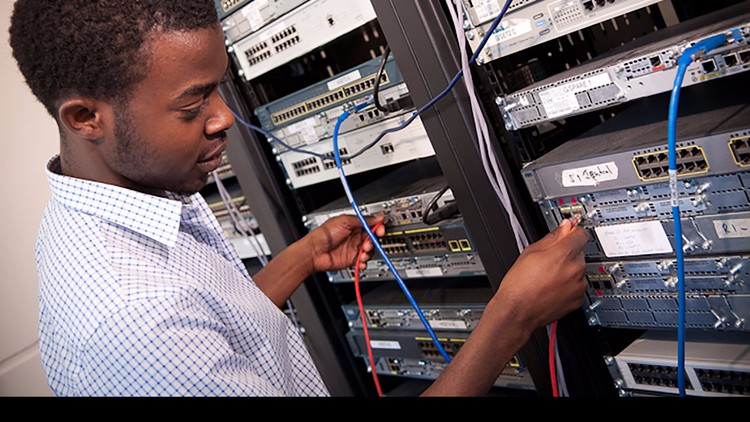
A Course Given in Most Universities to Teach Computer Networks & OSI Layers to Computer/Electrical Engineering Students
What you will learn
The Detailed Functionalities of the 7 OSI Layers in Computer Networks
The Networking Devices including routers, switches, hubs, etc.
Basics of Switching and Routing Concepts.
Application layer job in the OSI/TCP-IP model
Presentation layer job in the OSI/TCP-IP model
Session layer job in the OSI/TCP-IP model
Transport layer job in the OSI/TCP-IP model
Network layer job in the OSI/TCP-IP model
MAC/DLL layer job in the OSI/TCP-IP model
Physical layer job in the OSI/TCP-IP model
Description
Computer Networks for beginners
Computer networks are a growing trend. You can find them at your home, school, work, and most of the places you go daily. In this course, you will learn the basic concepts of computer networks. Specifically, you are expected to achieve the following milestones:
- Become aware of networks surrounding you
When you start noticing networks around you, you will also understand the big part of the IT world. You will learn how the Internet works, how your Internet Service Provider (ISP) allows you to connect online, how people share data without Internet access, and much more. Everything starts by becoming aware of computer networks.
- Learn how to set up a network
Whether you are taking this course to improve yourself, to get a better grade at school, or because of work, setting up a network is a skill that is very useful today. Yet many people do not know how to do it. You have an opportunity to learn it in a few minutes.
- Learn how to protect yourself in a network, including the Internet
Unwanted sharing of passwords, pictures, documents, credit card numbers, and internet activity is not something anybody would want to share. But, with the expanded usage of computer networks, privacy is becoming an abstract term. This course helps you protect yourself when going online, and also protects your home/office network.
Who is this course for?
- Anyone who wants to learn the most important concepts of Computer Networks
- A person who just wants to learn how the Internet works
- Anyone who is studying for their Computer Network exam.
What will you learn?
As I wrote earlier, you will learn the most important concepts of Computer Networks. The exact topics include:
- Types of networks (size, topology)
- Cables in computer networks
- TCP/IP architecture
- ISO/OSI model
- IP protocol (IP address, routing)
- TCP & UDP – How they work and what they do
- TCP – Connection management.
What things do I need?
To take this course, you only need your computer or smartphone and an internet connection. Also, if you don’t understand something or if you need help with something. You can always reach out to me. Mostly I respond within a day. At the end of this course, You will get a certificate of completion. That you can put on your resume or your link in your profile.
So do you want to learn how the internet works? Enroll today and I will see you in the course.
======== About the Insturctor ===========
Jehad M. HAMAMREH ([email protected]) is the Founder and Director of WISLABi/com, Editor at Researcherstore/com & RS-OJICT journal, as well as A. Professor with the Electrical and Computer Engineering Department, Antalya International (Bilim) University. He earned his Ph.D. degree in Telecommunication Engineering and Cyber-Systems from Medipol University. Previously, he worked as a Researcher at the Department of Electrical and Computer Engineering at Texas A&M University. He is the inventor of more than 20 Patents and has authored more than 90 peer-reviewed scientific papers along with several book chapters. His innovative patented works won the gold, silver, and bronze medals in numerous international invention contests and fairs.
His current research interests include Wireless Communication, Wireless Security, Wireless Sensing, O-RAN, 5G/6G, IoT, AI/ML, wireless physical and MAC layers security, orthogonal frequency-division multiplexing (OFDM), multiple-input multiple-output systems (MIMO), advanced waveforms design, multidimensional modulation techniques, and orthogonal/non-orthogonal multiple access schemes for future wireless systems. He is a regular investigator and a referee for various scientific journals as well as a TPC member for several international conferences. He is an Editor at RS-OJICT and Frontiers in Communications and Networks.
Key Research Topics: Wireless Communication, Wireless Security, Wireless Sensing, Open RAN, 5G/6G, IoT-AI
Content